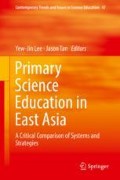Abstract
This chapter reviews the state of primary science education in China and those factors or policies that have been most closely associated with its development in the country especially from major science curriculum reforms since the 2000s. We examined policies that had influenced curricula from the early years to current calls for quality education (including that of assessment) that advances national science and technology goals. Reforms since 2004 have been extensive with most primary schools now adopting new science curriculum standards and textbooks. Production of the latter has been prolific with many alternatives available that are supported by teaching handbooks. The influential “A long-term plan on education reform and development (2010–2020)” promoted the use of scientific experiments, practices, and skills training in science, which was a significant development. Apart from describing how China has tried to ameliorate the urban-rural disparities in education, we discuss how science has been promoted actively through informal science learning initiatives here and through the popular Learning by Doing and Learn to Think programs. We describe some of the success of these important projects but cast a critical eye on their challenges of implementation too. Because teachers are the primary agents of change, we devote space to explain how teachers here are trained at preservice and in-service levels. Supporting professional development, the National Training Plan has organized capacity building workshops on various topics as well as those that integrate teaching theory with classroom practice and collaborative discussions of teaching experiences. We close this chapter by describing how science curriculum is managed in China and some feedback by learners on the former.
Access this chapter
Tax calculation will be finalised at checkout
Purchases are for personal use only
Notes
- 1.
It means no charges of tuition and miscellaneous fees while having allowances for boarding living expenses.
References
Adelainde. (2009). Curriculum reform and ‘quality education’ in China: An overview. International Journal of Educational Development, 29, 241–249.
Chinese Association of Science and Technology. (2002). Report on Chinese public scientific literacy in 2001. Beijing: Science Popularization Publication.
Chinese State Council. (2006). The programme for national science literacy promotion action (2006–2020). Beijing: The State Council (in Chinese).
Ding, B.-P. (2011). Science teacher education for primary schools in China: Status quo, problems and recommendations. Contemporary Teacher Education, 6, 1–7 in Chinese.
Guo, G. Z. (2014). The theory and practice study of informal science curriculum and its development (Unpublished PhD. Thesis). Northeast Normal University, China. (in Chinese).
Hu, W.-P., Adey, P., Jia, X.-J., Liu, J., & Zhang, L. (2011). Effects of a ‘learn to think’ intervention programme on primary school students. British Journal of Educational Psychology, 81, 531–557.
Lai, F., Liu, C.-F., et al. (2014). The education of China’s migrant children: The missing link in China’s education system. International Journal of Educational Development, 37, 68–77.
Lai, X.-L., & Ding, Z.-Y. (2005). Learning by doing’: A form of science education for children. Educational Research, 6, 89–93 in Chinese.
Liu, X.-F., Liang, L.-L., & Liu, E.-S. (2012). Science education research in China: Challenges and promises. International Journal of Science Education, 34, 1961–1970.
Ministry of Education. (2001). The outlines for curriculum reform in elementary and secondary education (experimental version). Beijing: Ministry of Education of China (in Chinese).
Ministry of Education. (2012). ‘National Training Plan (NTP)’ curriculum standard (experimental version). Beijing: Ministry of Education of China (in Chinese).
OECD. (2013). Lessons from PISA 2012 for the United States, strong performers and successful reformers in education. From https://doi.org/10.1787/9789264207585-en.
Poisson, M. (2000). Science education for contemporary society: problems, issues and dilemmas. Final report of the international workshop on the reform in the teaching of science and technology at primary and secondary level in Asia: Comparative references to Europe. From http://www.ibe.unesco.org.
State Council of the People’s Republic of China. (2010). Outline of national action scheme of scientific literacy for all Chinese citizens (year 2006, 2010 and 2020). Beijing: State Council of the People’s Republic of China (in Chinese).
Wan, D.-S., & Zhang, H.-X. (2013). Predicaments of the development of informal science education in China and its path choice—Based on the experience of the US. Education Science, 8, 6–11 in Chinese.
Wang, S., Liu, X.-F., & Zhao, Y.-D. (2012). Opportunities to learn in school and at home: How can they predict students’ understanding of basic science concepts and principles? International Journal of Science Education, 34, 2061–2088.
Yang, Q. -L.(2013). Discussion on suitableness of reform for curriculum and instruction in basic education. Education Research Monthly, 11, 3–8 (in Chinese).
Yang, J., Huang, X., & Liu, X. (2014). An analysis of education inequality in China. International Journal of Educational Development, 37, 2–10.
Zhang Y. -P. (2015). Review on education in rural primary school science. Journal of Nanjing Xiaozhuang University, 3, 38–42 (in Chinese).
Author information
Authors and Affiliations
Editor information
Editors and Affiliations
Rights and permissions
Copyright information
© 2018 Springer International Publishing AG, part of Springer Nature
About this chapter
Cite this chapter
Hu, W., Shou, X. (2018). Primary Science Education in China. In: Lee, YJ., Tan, J. (eds) Primary Science Education in East Asia. Contemporary Trends and Issues in Science Education, vol 47. Springer, Cham. https://doi.org/10.1007/978-3-319-97167-4_4
Download citation
DOI: https://doi.org/10.1007/978-3-319-97167-4_4
Published:
Publisher Name: Springer, Cham
Print ISBN: 978-3-319-97165-0
Online ISBN: 978-3-319-97167-4
eBook Packages: EducationEducation (R0)

